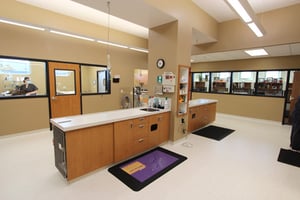The healthcare industry is constantly evolving, driven by advancements in technology, shifts in patient care philosophies, and the ongoing need for facilities to adapt to changing health challenges. Within this dynamic landscape, custom millwork can play an important role in creating healthcare spaces that are not only functional but also healing and welcoming. Let's dive into the latest innovations in healthcare millwork and the trends that are setting the stage for the future of medical facility design.
Antimicrobial Surfaces
One of the most critical concerns in healthcare design is infection control. Innovations in millwork now include the integration of antimicrobial surfaces, which inhibit the growth of bacteria and viruses. These surfaces are not limited to countertops and high-touch areas; recent advancements have made it possible to infuse antimicrobial properties into a wide range of millwork components, including door handles, cabinetry, and even wall paneling. This trend represents a significant leap forward in the industry's ongoing battle against healthcare-associated infections (HAIs).
Flexible and Modular Design
The need for healthcare spaces to adapt quickly to changing needs—whether to accommodate new technologies, respond to health crises, or simply update facilities for improved patient care—has led to an increased focus on flexibility. Modular millwork solutions are at the forefront of this trend, offering customizable components that can be reconfigured or relocated as needed. This adaptability extends from patient rooms to nurse stations and beyond, ensuring that healthcare environments can evolve without the need for extensive renovations.
Integrated Technology
As digital technology becomes increasingly integral to patient care, millwork design has evolved to incorporate these technological needs seamlessly. This includes built-in charging stations, tech-ready furniture, and cabinetry designed to house and conceal medical equipment and electronic health record (EHR) systems. The integration of technology into millwork not only supports the functionality of healthcare spaces but also maintains design aesthetics by minimizing clutter and streamlining the appearance of technological components.
Eco-friendly Materials and Practices
Sustainability is a growing concern in all sectors, including healthcare. The use of eco-friendly materials in millwork, such as sustainably sourced wood products and low-VOC (volatile organic compounds) finishes, is on the rise. This trend not only supports environmental sustainability but also contributes to the creation of healthier indoor environments for patients and staff.
Biophilic Design Elements
Biophilic design, which incorporates natural elements into built environments to promote well-being, is gaining traction in healthcare millwork. This can include the use of materials that evoke a connection to nature, as well as designs that mimic natural forms and patterns. Biophilic millwork can help reduce stress and anxiety among patients and staff, creating a more healing and restorative environment.
Enhanced Patient Privacy
With patient privacy and comfort being paramount, millwork designs are increasingly focusing on creating spaces that offer seclusion and tranquility. This includes innovations such as sound-absorbing millwork panels and privacy screens that can be easily moved or adjusted. By enhancing patient privacy through thoughtful millwork design, healthcare facilities can improve the overall patient experience.
Conclusion
Innovations in healthcare millwork are transforming medical facilities into spaces that better meet the needs of patients and healthcare providers. From antimicrobial surfaces and flexible designs to the integration of technology and eco-friendly practices, these trends highlight the industry's commitment to creating environments that are not only functional but also conducive to healing. As we look to the future, it's clear that millwork will continue to play a vital role in shaping the evolution of healthcare spaces, making them safer, more adaptable, and more welcoming.
Topics: healthcare






.png?width=203&height=142&name=IFA%20Member%20Logo%20EPS%20(1).png)
.png%20for%20web.png?width=203&height=94&name=2022_VetFran_Logo%20(002).png%20for%20web.png)
.png?width=203&height=150&name=ICSC-logo-tag-full-color%20(1).png)